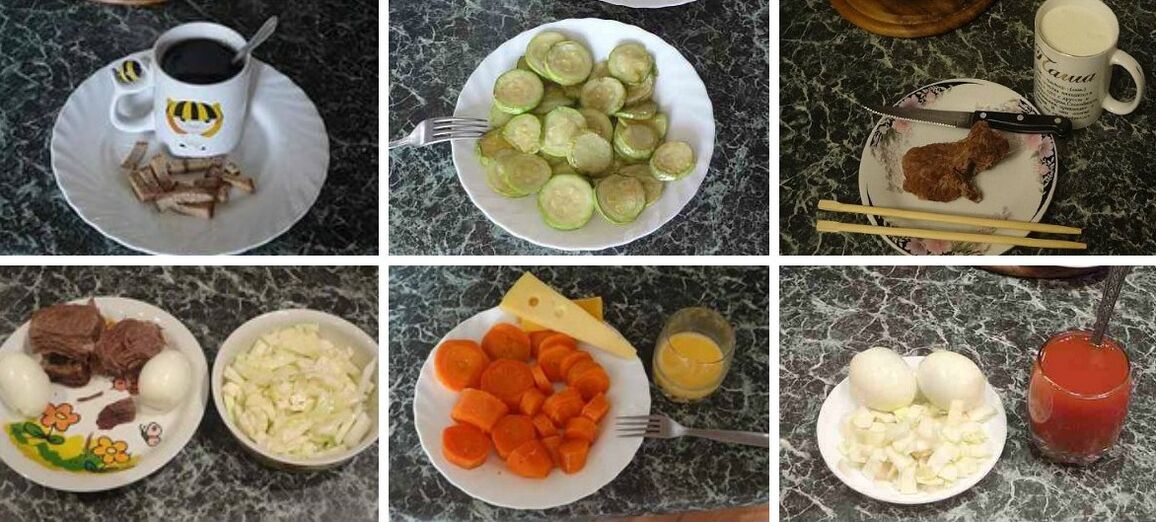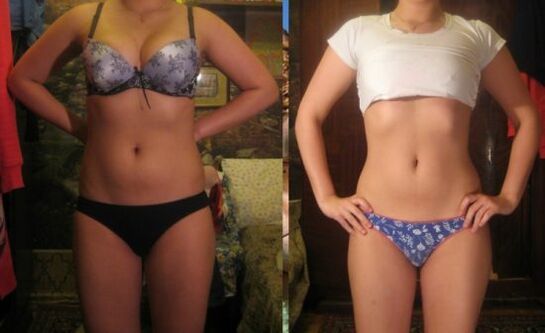The Japanese diet is the most effective among similar nutrition systems. Despite the fact that it lasts a limited number of days - from 7 to 14, the result remains amazing. By this method, you can remove up to 8-14 kg. During this time, the metabolic processes in the body undergo a qualitative restructuring, and according to the developers, further weight gain does not occur for a long period. True, the wrong exit from the diet does not allow many to verify the correctness of these words.
Diet feature
The main feature of the Japanese diet is that the choice of products is very limited, and the diet is meager and even specific. This protein technique has a very important rule, salt is not used at all in cooking.

Such a restriction explains why it cannot be maintained for more than two weeks, since salt is an important product for the life of the body, and its complete absence in the human diet for a long time negatively affects health.
Food with a high calorie content is removed from the menu, the diet is strictly scheduled, which allows you not to count the calorie content and energy value of dishes. Products are available, losing weight noted that much less money is spent on food during this period.
It is important that you should eat on this system strictly three times a day, this attracts working and studying women. The introduction of boiled cabbage into the menu allows you to gently cleanse the intestines and eliminate problems with the stool.
There is no full breakfast, it is replaced by a cup of coffee, which has a diuretic and tonic effect. Therefore, it is believed that such a significant weight loss is achieved for the most part due to the loss of body water.
The presence of protein foods allows you to maintain muscle mass. The body spends a lot of time on its assimilation, this helps to speed up the metabolism. At the same time, the diet can hardly be called balanced; a person receives less vitamins, minerals and other useful substances.
In this regard, deterioration of well-being and a decrease in immunity are possible. It is important to take complex vitamins. Before using this diet, be sure to consult your doctor.
A mandatory component of the salt-free Japanese diet, which makes it easier to start and maintain, is the preparatory stage. About a week before the performance, you should give up fatty, salty, sweet, reduce the calorie content of the daily diet by 20%.
After waking up, you need to drink a glass of water, this will make it easier to refuse hearty breakfasts in the future. And also pure water helps to improve metabolism. While maintaining the system, you must follow a number of rules of the Japanese diet.
Basic principles
The rules of the Japanese diet include the following prerequisites:
- Complete exclusion from the diet of foods with the addition of salt and sugar, as well as various seasonings that stimulate appetite.
- Daily calorie content should not exceed a total of 1200 kcal. The main principle of the system is moderation in food, and even rigor.
- Alcohol is absolutely not. From drinks, it is allowed to use natural coffee, green tea without additives, mineral non-carbonated water.
- The basis of the diet is protein foods and vegetables. The use of boiled, steamed and fried chicken, veal, lean fish is welcome. You can add vegetable oil.
It is important to use only certain foods for cooking, days and meals are strictly scheduled, you cannot change their sequence. You can replace the zucchini with other vegetables - carrots, beets, pumpkin.
Duration
There are three types of salt-free nutrition system:
- For 7 days. This time is enough to start changes in metabolism. But weight loss in a week is achieved for the most part due to the removal of water from the body;
- For 13 days. This system is the most popular, the set of products is strictly scheduled. Before you start a diet, you should buy what you need at the nearest store;
- For 14 days. The difference with the previous option is insignificant, the question is whether the losing weight wants to hold out for another day.
Every day in their diet, the Japanese use the following mandatory set of products:
- 200-300 g long grain rice. You can choose any variety that you like;
- 100-250 g of any fruit, it is advisable to buy seasonal fruits that grow in the region of residence;
- 50-60 g of beans or peas;
- ½ cup milk, whole pasteurized product is used, and 1 egg, which can be consumed raw or boiled;
- Vegetable oil;
- A small piece (palm-sized) of fish in any form. There are no restrictions on fat content, you can choose river or sea fish.
In general, for two weeks of the diet you will need:
- A pack of natural coffee;
- Two packages of eggs;
- 2 kg of fish;
- 1 kg of beef or veal;
- 2 kg of chicken meat;
- Olive and vegetable oil;
- 2 kg of carrots;
- 1 kg of zucchini;
- 2 medium heads of cabbage (you can use Beijing salad);
- 1 kg of fruit (for example, green apples);
- 2 l box of tomato juice;
- 1 liter of kefir;
- 3-4 lemons;
- 1 loaf of black bread for making croutons.
As you can see, there is no particular variety in nutrition, but it is difficult to call the system rigid in terms of the choice of products. This is clearly an adapted version for people from other countries.

Menu for 14 days
Breakfast, according to the rules of the system, is excluded. It is replaced with an obligatory cup of fragrant coffee without sugar, you can add a piece of dried bread every other day. At the exit stage, breakfast may consist of an unsalted omelet or oatmeal in water, of course, without the addition of butter and sugar, and a couple of toasts will be allowed to be added to coffee.
The lunch menu might look like this:
- Boiled cabbage with butter, boiled egg and a glass of tomato juice;
- Vegetable coleslaw salad with fried cod steak;
- Fried zucchini slices;
- Boiled carrots with grated cheese, raw egg;
- Fresh carrot salad with lemon juice;
- A piece of boiled chicken with carrot and cabbage salad;
- A piece of boiled beef and fruit.
For dinner, you can cook the following dishes:
- Fried or steamed cod;
- A piece of baked veal, a glass of kefir;
- Boiled eggs, a piece of chicken and fresh cabbage;
- Grated carrots with butter, boiled quail eggs;
- Fried fish, a glass of curdled milk;
- Fruits.
What results can you expect
There is no guarantee that the diet will act on a person as promised, it all depends on the individual characteristics and physique of the person, the number of extra pounds. The result in any case will be if all the rules are followed. On average, according to the reviews of losing weight, it takes up to 3-5 kilograms per week.

Reviews of those who have lost weight
- The first review, a girl, 27 years old: "For a long time ago I was on the so-called salt-free diet, I was quite pleased with it. I didn’t notice any particular rigidity, and so I eat a little, the amount of food that I should have adhered to was enough for me. Despite the fact that I like to eat a variety of foods. But in two weeks I lost only 4 kg, I think that this system is not enough. I expected more. I won't use it in the future. "
- The second review, a woman, 29 years old: "The Japanese diet is a good thing, I can’t say that it is very tough, even eating a lot is not recommended. It is important that it teaches healthy food, of course, the calorie content is low, but this is a diet! And it's about weight loss. I was 89 kg, in two weeks I became 82, the result is normal. This system forced me to reconsider my eating habits, I was able to easily give up my favorite chips, buns, rarely began to cook pasta and potatoes. If before I quickly gained weight, now it’s just that if I feel heaviness, I replace dinner with kefir for a couple of days, and everything will return to normal. "
- The third review, a woman, 32 years old: "On the advice of a friend, I tried the Japanese diet, my result was minus 6 kg in two weeks, then 3 kg were gone within a month. I heard a lot of positive reviews about her, but I ventured to try only when I myself realized that something needed to be changed. The beginning was difficult, even the preparatory period was difficult for me, I got used to eating sweets and using various seasonings for cooking, but even salt is not allowed here. But my principle won to bring everything to the end, and at the slightest attempt to break loose, I went away from the refrigerator. My review is positive, even after the diet, the weight is maintained. My friend scored quickly, but then admitted that she started drinking beer with fish again, that's the result.
- The fourth review, a woman, 34 years old: "I gained weight after the birth of my second baby. For a long time I dreamed of losing weight again, but it still didn’t work out. So I set out to fit into my favorite dresses that took up space in the closet, but did not fit on me. I tried the Japanese diet, it was easy enough for me to maintain it. For household chores, she could not think about food. I also added light exercises in the morning, inclinations, swings and more. As a result, 8 kg were lost in 14 days, and another 3 kg are at the exit stage. It remains to overcome yourself, throw off another 2 kg and return to the previous indicators.
- Fifth review, woman, 39 years old: "I tried to hold out for more than two weeks, but the dynamics of weight loss did not please me, so I decided to end it. At the beginning of the diet, I thought how I would finish, I would just eat sausage with loaves and buy myself a big delicious cake. To be honest, during this time, exotic fantasies have subsided, and I can easily do without sweets. From the diet, I later left the principle of fractional nutrition, and I take a standard set to work - meat or fish and a salad for lunch and apples for snacks. It is more comfortable. In general, two weeks of sitting on a Japanese diet is the most it, it makes no sense for longer. "
Recipes for allowed dishes
The choice of dishes to support the Japanese diet is rather limited. It is worth remembering that salt and the usual seasonings cannot be used, so the food has a natural taste, which is somewhat unusual for a modern person.
Cod baked
Rinse half a kilogram of cod fillet and dry with a towel. Prepare a marinade from lemon juice and two teaspoons of vegetable oil, put fish in it for half an hour. Lay a sheet of foil on a baking sheet, put the fish in one layer. Bake at 180 degrees for 20-25 minutes.

raw carrot salad
On this diet, carrot salads are prepared in two versions - from raw and boiled vegetables. Wash and peel medium-sized carrots, grate on a coarse grater. Season with vegetable oil, add a couple of drops of lemon juice for taste.
Boiled carrot salad
Boil the carrots in the skin, then peel and rub on a coarse grater. Then it can be lightly stewed in vegetable oil, sprinkled with grated cheese on top, which will give the dish a little piquancy.
boiled cabbage
This dish perfectly normalizes the work of the intestines, acting very gently. Chop the leaves of fresh white cabbage and boil for a few minutes in a small amount of water, put in a colander, let the water drain. Heat two teaspoons of oil in a frying pan and lightly fry the cabbage. Alternatively, you can add a boiled egg to the cabbage.

fried zucchini
Peel young zucchini, cut into circles or strips. Fry in vegetable oil on both sides, without salt. To improve the taste, you can sprinkle the finished dish with lemon juice. It is not forbidden to cook vegetables on the grill or in the oven.
Croutons for the morning
Cut two slices of rye bread into cubes or rectangles, put on a dry frying pan and lightly fry until a light crust forms. You can make croutons in the oven, for this, put the prepared bread on a baking sheet and bake for 10 minutes at a temperature of 200 degrees.
How to get out of the diet
It is important not only to properly prepare for this strict diet, but also to exit correctly. This is a very important period, you need to restrain yourself and not attack food. During this period, there is still an active weight loss, because the processes launched in two weeks are working. Introduce the usual dishes into the diet should be carefully and in small portions.
It is advisable to continue to adhere to the principle of a healthy diet during the period of leaving the diet, that is, to choose only natural products. To consolidate the result, the exit period should be twice as long as the duration of the system. If a two-week diet was chosen, that the withdrawal period would be at least 4 weeks.
In the first week, you should increase the consumption of meat and fish dishes by 20-50 percent, add cereals and omelettes for breakfast to the menu. This will help the body to adapt after prolonged refusals of the morning meal.
It is also necessary to add food little by little, the first weeks of 5 g per day are enough. For 28 days, you should not give up fractional nutrition, reduce the amount of protein foods, other fruits and dairy products should be added to the diet.
Another important nuance that allows you not to break loose and keep the weight. Once a week, you should definitely pamper yourself with your favorite, but not entirely healthy high-calorie dish. This calorie-loaded day is offset by another low-calorie day.
Only a patient and slow exit from the diet will allow you to keep the result for a long time and enjoy your slender beautiful body!












































